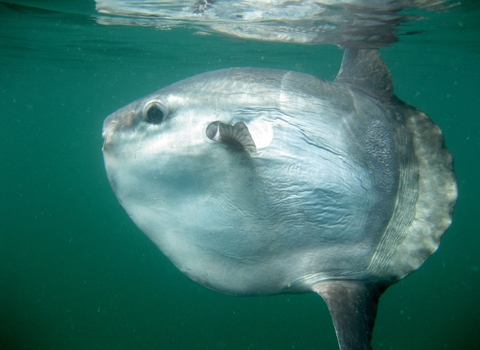
Sunfish ©Pete Mills
Sunfish
The ocean sunfish is the second largest bony fish on the planet and visits UK seas during the summer months to feast on jellyfish.
Scientific name
Mola molaWhen to see
June to SeptemberSpecies information
Statistics
Length: up to 332.7cm Weight: up to 1,320kgListed as Vulnerable on the IUCN Red List, but on a regional scale they are data deficient (meaning we don't know enough about the population to judge their conservation status).
Habitats
About
The ocean sunfish is an odd looking fish. It is huge, flat and circular - looking pretty much like a giant swimming head. Instead of a tail, it has a stiff fringe of skin (called a clavus), which it can move to act like a ship's rudder. It also has two small pectoral fins and an elongated dorsal fin and anal fin that look a bit like wings. Their scientific name of Mola means millstone in latin - and it's easy to see where it came from!They are often spotted resting on their sides at the surface of the sea, supposedly basking in the sunshine - which is where its English name of sunfish comes from. It has been suggested that this basking behaviour is to help the sunfish raise its body temperature after diving down to cooler waters to feed. The fin at the surface can easily be mistaken for a shark, but once up close they are unmistakeable.
Sunfish feed on jellyfish and salps (as such they are known as jellivores!), as well as a wide range of other animals. Smaller sunfish have the most varied diet - when they're under one metre in length, around half of their diet is jellyfish and the other half is a mix of species that live on the seafloor, like crustaceans, molluscs, and even some fish.
Ocean sunfish have a wide range and are found across tropical and temperate waters; they have been noted across the length of the Atlantic from Iceland to Chile. In the UK, they're most commonly seen in summer months.
The ocean sunfish used to be considered the largest bony fish in the world, but recently scientists discovered that its close relative, the southern sunfish (Mola alexandrini), is actually larger! Both fish can reach a similar length, but the southern sunfish is thought to be much heavier, with one fish recorded weighing 2,300kg. Both of these fish belong to the Molidae family, which contains five species (Mola mola, Mola tecta, Mola alexandrini, Masturus lanceolatus, and Ranzania laevis).
